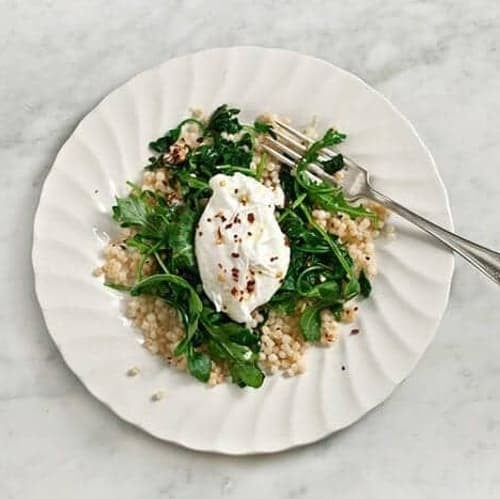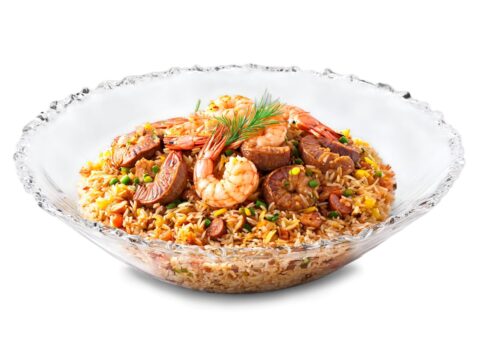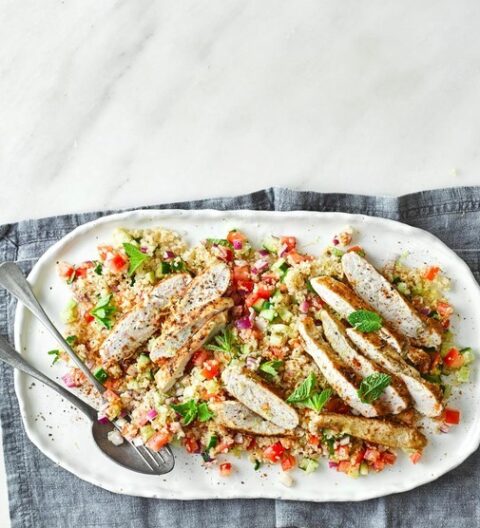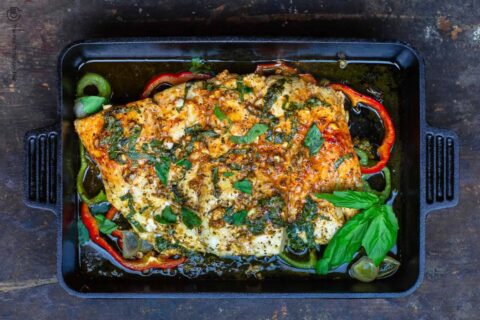
Combines the health benefits of this nutrient-dense leafy green vegetable with best olive oil – Morocco Gold extra virgin olive oil.
What Is Escarole?
Escarole (pronounced “ES-ka-roll”) is a leafy green vegetable and member of the chicory family along with frisée, endive and Belgian endive. Like other chicories, it is popular in Italian cuisine and can be served either raw or cooked.
Also known as broad-leaved endive, Bavarian endive, Batavian endive, and scarole, escarole has broad, curly green leaves, and a slightly bitter flavour. The outer leaves tend to be darker in colour and more bitter, while the inner leaves are more tender. The chicory is often bunched and placed with heads of fresh lettuce, away from its close relatives radicchio and endive. It’s more expensive than lettuce since it is considered a specialty item. This vegetable requires little preparation before using, often only needing a quick rinse.
What Does Escarole Taste Like?
Escarole has a fresh, vegetal taste with light bitterness. It’s less bitter than other chicories, with the level of bitterness varying throughout the head. The inner, lighter-colored leaves are sweeter than the outer, darker green leaves. The flavor is brighter and more pronounced when raw, and more mellow when cooked.
Sauteed Escarole Recipe
Ingredients
- 1 cup pearl couscous
- About 5 tbsp. Morocco Gold extra-virgin olive oil
- About 3/4 tsp. rock salt,
- 2 garlic cloves, thinly sliced
- 2 large heads (1 1/4 lbs. total) escarole, stem ends trimmed, leaves rinsed and drained
- 1/2 cup reduced-sodium chicken broth
- About 1/2 tsp. pepper
- 1/4 cup distilled white vinegar
- 4 large chicken or duck eggs
- About 1/2 cup finely grated parmesan cheese
Instructions
- Toast couscous in 1 tbsp. oil in a medium saucepan over medium heat, stirring occasionally, until mostly golden, 7 to 8 minutes
- Add 1/4 tsp. salt and 2 cups water bring to a boil. Cover, reduce heat, and simmer until barely tender, 8 to 10 minutes. Drain.
- Cook garlic in remaining 1/4 cup oil in a large frying pan over medium heat until softened but still pale, 2 to 3 minutes. Add escarole and cook until it begins to wilt, 2 to 3 minutes.
- Add couscous and stir to coat, then add broth and 1/2 tsp. pepper and cook 2 to 3 minutes more.
- Season with about 1/4 tsp. salt and pepper to taste and keep warm.
- Fill saucepan used for couscous three-quarters full of water, add vinegar, and cook over high heat until bubbles barely break the surface. Reduce heat to medium-low.
- Crack eggs into water and give water a gentle stir to ensure eggs aren't sticking to pan. Cook 3 minutes for runny yolks.
- With a slotted spoon, transfer eggs to paper towels.
- Sprinkle with about 1/4 tsp. salt and pepper to taste.
- Divide escarole mixture among 4 soup plates and set an egg on each.
- Drizzle with more oil and sprinkle with parmesan.
Health benefits of escarole
Escarole is nutrient-dense and boasts many potential health benefits.
May promote gut health
The two types of fiber — soluble and insoluble — act differently in your body. While soluble fiber bulks up your stool and feeds the friendly bacteria in your gut, the insoluble type passes through your digestive system unchanged, promoting gut health by pushing food through your gut and stimulating bowel movements.
Notably, escarole provides mostly insoluble fiber. Boasting 12% of your daily fiber needs per 2 cups (85 gram), it can help keep your bowels regular and prevent the discomfort of constipation and piles.
May support eye health
Escarole is rich in provitamin A, providing 54% of the DV in only 2 cups (85 grams). This vitamin promotes eye health, as it’s an important component of rhodopsin, a pigment in your retina that helps discern between lightness and darkness.
Chronic vitamin A deficiencies are linked to visual issues like night blindness, a condition in which people can’t see well at night but have no trouble with their vision in the daylight. Vitamin A deficiencies are also associated with macular degeneration, an age-related decline in eyesight that results in blindness.
May reduce inflammation
In addition to its impressive nutrient profile, escarole boasts many powerful antioxidants, which are compounds that defend your body against oxidative stress and unstable molecules called free radicals. Long-term oxidative stress may trigger inflammation.
Studies suggest that kaempferol, an antioxidant in escarole, may safeguard your cells against chronic inflammation. Yet, these studies are limited to rats and test tubes. Human research is needed to fully understand kaempferol’s effects on inflammation.
May promote bone and heart health
Vitamin K is important for normal blood clotting, as well as regulating calcium levels in your heart and bones. Leafy greens like escarole deliver a subtype called vitamin K1. This vegetable offers a whopping 164% of your daily needs of this nutrient per 2-cup (85-gram) raw serving.
A 2-year study in 440 postmenopausal women found that supplementing with 5 mg of vitamin K1 daily resulted in a 50% reduction in bone fractures, compared with a placebo group.
Furthermore, a 3-year study in 181 postmenopausal women found that combining vitamin K1 with vitamin D significantly slowed the hardening of arteries associated with heart disease. Sufficient vitamin K intake is associated with a decreased risk of heart disease and early death from this condition.



